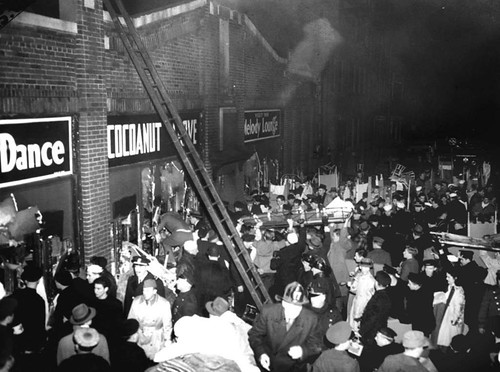A fire in the Cocoanut Grove in Boston nightclub kills 492 people.
The Cocoanut Grove Fire was a nightclub fire in the United States. The Cocoanut Grove was a premier nightclub during the post-Prohibition 1930s and 1940s in Boston, Massachusetts. On November 28, 1942, it was the scene of the deadliest nightclub fire in history, killing 492 people and injuring hundreds more. The scale of the tragedy shocked the nation and briefly replaced the events of World War II in newspaper headlines. It led to a reform of safety standards and codes across the US, and to major changes in the treatment and rehabilitation of burn victims internationally.
It was the second-deadliest single-building fire in American history; only the 1903 Iroquois Theatre fire in Chicago had a higher death toll, of 602. It was only two years after the Rhythm Club fire which had killed 209.
Official reports state that the fire started at about 10:15 pm in the dark, intimate Melody Lounge downstairs. Goody Goodelle, a young pianist and singer, was performing on a revolving stage, surrounded by artificial palm trees. The lounge was lit by low-powered light bulbs in coconut-styled sconces beneath the fronds. A young man, possibly a soldier, had unscrewed a light bulb in order to give himself privacy while kissing his date. Stanley Tomaszewski—a 16-year-old busboy—was instructed to put the light back on by tightening the bulb. He stepped up onto a chair to reach the light in the darkened corner. Unable to see the bulb, he lit a match to illuminate the area, tightened the bulb, and extinguished the match. Witnesses first saw flames in the fronds, which were just below the ceiling, immediately afterward. Though the lit match had been close to the same fronds where the fire was seen to have begun, the official report determined that Tomaszewski’s actions could not be found to be the source of the fire, which “will be entered into the records of this department as being of unknown origin.”

